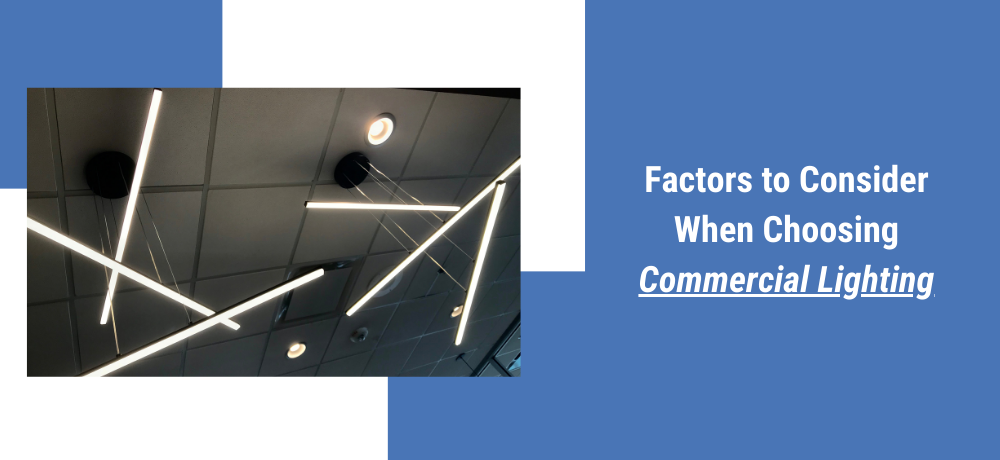Factors to Consider When Choosing Commercial Lighting

Commercial lighting is a crucial aspect of any business or workspace. It not only affects the aesthetics and ambiance of the area but also plays a significant role in energy efficiency and productivity. When selecting commercial lighting, there are several important factors to consider. In this comprehensive guide, we will delve into the key factors to keep in mind when choosing commercial lighting solutions.
Lighting Type
Ambient Lighting
Ambient lighting provides overall illumination to a space. When choosing ambient lighting for commercial spaces, consider the size and layout of the area. Large open spaces may require powerful overhead fixtures, while smaller offices may benefit from softer, more diffused ambient lighting.
Task Lighting
Task lighting is designed to provide focused illumination for specific activities. Think about the tasks performed in your commercial space. For instance, offices may need desk lamps or under-cabinet lighting in kitchens. Task lighting should be adjustable and easily directed to suit individual needs.
Accent Lighting
Accent lighting is used to highlight specific features or areas within a commercial space, such as artwork, architectural details, or product displays. When selecting accent lighting, consider the desired effect and the color temperature of the light to create the desired ambiance.
Energy Efficiency
LED Lighting
LED (Light Emitting Diode) lighting is known for its energy efficiency. LED fixtures use significantly less energy than traditional incandescent or fluorescent bulbs, resulting in lower electricity bills and reduced carbon emissions. Consider investing in LED lighting to save on long-term operating costs.
Energy Star Certification
Look for commercial lighting fixtures that carry the Energy Star certification. This designation signifies that the product meets strict energy efficiency guidelines set by the Environmental Protection Agency (EPA). Energy Star-rated fixtures not only save energy but may also qualify for rebates and incentives.
Lighting Controls
Implementing lighting controls such as occupancy sensors and dimmer switches can further enhance energy efficiency. These controls allow you to adjust lighting levels based on occupancy and natural light, reducing energy consumption when full illumination is not needed.
Color Temperature
Warm vs. Cool Lighting
Color temperature is measured in Kelvin (K) and refers to the warmth or coolness of light. Warm lighting (2700K-3500K) creates a cozy, inviting atmosphere, while cool lighting (4000K-5000K) is more energizing and suitable for task-oriented spaces. Consider the desired mood and functionality when selecting color temperatures.
Color Rendering Index (CRI)
The Color Rendering Index (CRI) measures how accurately a light source reveals the true colors of objects. For commercial spaces where color accuracy is essential, aim for lighting fixtures with a high CRI rating. A CRI of 80 or above is typically recommended for most applications.
Dynamic Lighting
In some commercial settings, dynamic lighting systems that can adjust color temperature throughout the day are becoming popular. This mimics natural daylight, which can enhance productivity and well-being among occupants.
Maintenance and Lifespan
Fixture Durability
Consider the durability and longevity of lighting fixtures. Commercial spaces often have high usage, so choose fixtures that are built to withstand frequent on/off cycles and extended use without deteriorating.
Maintenance Costs
Evaluate the long-term maintenance costs associated with the selected lighting. LED lighting, for example, has a longer lifespan and requires less frequent replacement compared to traditional bulbs. This reduces maintenance expenses over time.
Warranty
Check the warranty provided by the manufacturer. A strong warranty can provide peace of mind knowing that you are protected in case of defects or premature failures of lighting fixtures.
Compliance and Regulations
Building Codes
Ensure that your chosen commercial lighting solutions comply with local building codes and regulations. Non-compliance can result in costly fines and delays in project completion.
Accessibility Standards
Consider accessibility standards, especially in spaces open to the public. Adequate lighting and proper placement of fixtures are essential to accommodate individuals with disabilities.
Environmental Impact
Assess the environmental impact of your lighting choices. Opt for fixtures and bulbs that are environmentally friendly and minimize waste. Recycling programs for lighting components should also be considered.
Selecting the right commercial lighting involves a careful evaluation of lighting types, energy efficiency, color temperature, maintenance requirements, and compliance with regulations. If you are looking for the right commercial lighting, contact High Park Electrical, a reputable residential and commercial electrical contractor, who can provide expert guidance and installation services for your commercial lighting needs.
Get in touch with us today
To learn more about what we do, please click here. To contact us, please click here or call us at (416) 799-2335.